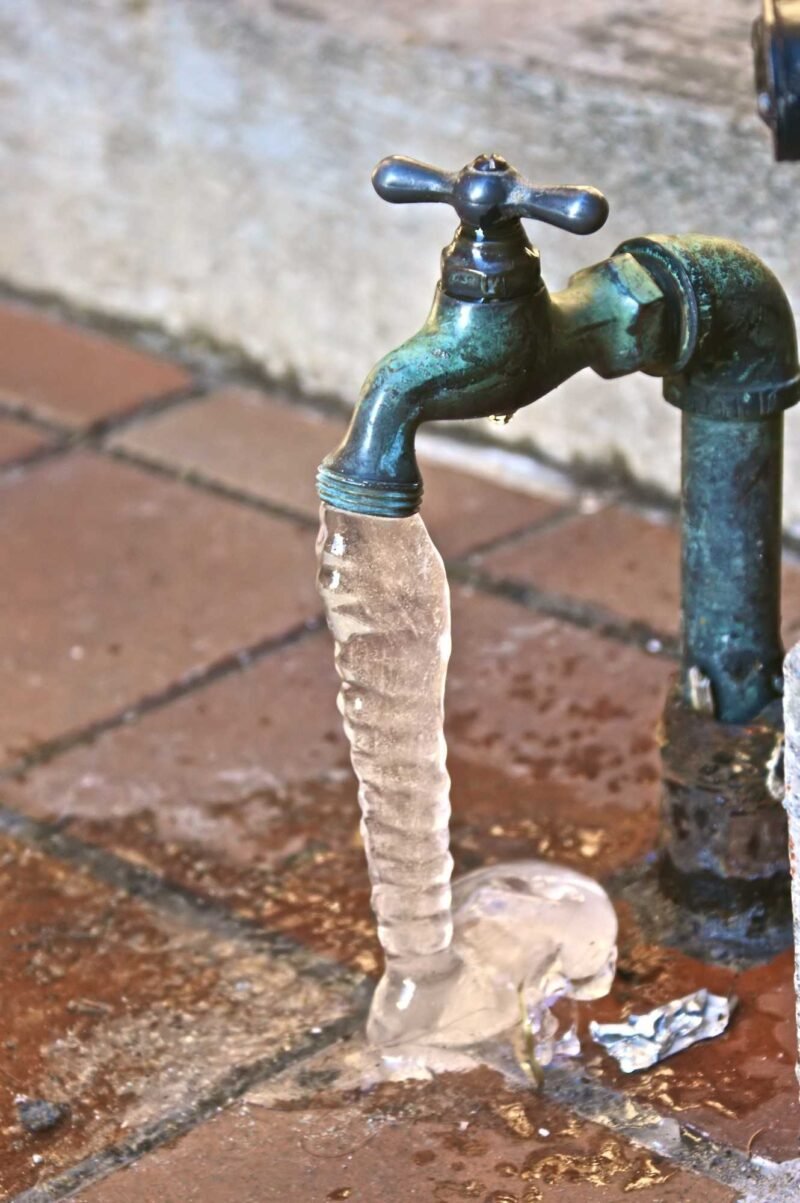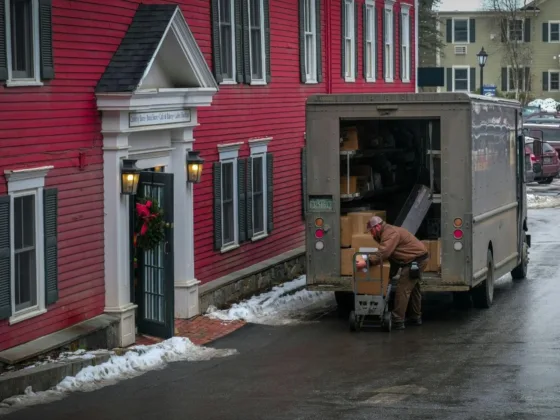Table of Contents Show
Introduction
When the temperature drops during winter, the risk of frozen pipes increases. This can lead to water damage and expensive repairs, turning your cozy home into a freezing mess overnight. It’s important to act quickly if you suspect your pipes are frozen, as prompt action can prevent further damage.
In this article, we’ll guide you through six essential steps to effectively deal with frozen pipes:
- Recognizing the signs of frozen pipes
- Taking immediate action
- Safely thawing your plumbing
- Preventing future freeze-ups
- Understanding homeowners insurance coverage
- Ensuring your home is well-protected against the cold
By following these steps and implementing preventive measures, you’ll not only be able to thaw your pipes but also safeguard your home from future freezing incidents. We’ll also discuss how homeowners insurance can help cover the costs associated with frozen plumbing.
It’s about peace of mind, knowing that when Jack Frost comes nipping, your home will stand resilient against the chill.

1. Understanding Frozen Pipes
When winter arrives, both the outside world and your home’s plumbing system feel the cold. Among the common issues during this time are frozen pipes, which can result in significant damage if not addressed promptly.
What Causes Pipes to Freeze?
The combination of dropping temperatures and poor insulation is what leads to frozen pipes. When the temperature falls below freezing point, any water inside your pipes can freeze. This frozen water then expands, exerting pressure on your pipes from within. If left unattended, this pressure can cause your pipes to burst, resulting in potential flooding and expensive repairs.
Warning Signs of Frozen Pipes
It’s crucial to identify frozen pipes early on to prevent these problems. Here are a few indicators that you may have a frozen pipe:
- Unexpected Noises: Unusual sounds like whistling or clanging when you turn on a faucet could be a sign of a blockage caused by ice.
- Reduced Water Flow: A noticeable decrease in water pressure or no water coming out at all often indicates a frozen pipe.
- Frost on Pipes: Visible frost on exposed pipes is an obvious indication of freezing.
- Odd Smells: If there’s a partial blockage in your pipe due to ice, it may push back and cause strange odors to emanate from your drains or faucets.
Remember that these signs alone do not guarantee a frozen pipe; they could also indicate other plumbing issues.
2. Common Signs of Frozen Pipes
Detecting frozen pipes can be challenging, especially when they’re hidden behind walls or under floors. However, there are several clear signs you should be aware of:
- No Water: When no water comes out of your faucets, it’s one of the most obvious indications.
- Strange Sounds: Unusual noises like banging, gurgling, or whistling can signify a frozen pipe.
- Persistent Cold: If your pipes consistently feel cold to the touch, they may be frozen.
- Visible Frost: When the frost is visible on a pipe, it’s a definite sign of a problem as the water inside is likely frozen too.
- Unpleasant Odors: These can arise from food or other waste being trapped behind the ice blockage.
If you notice any of these signs, it’s crucial to act promptly to prevent further damage.
3. What to Do If Your Pipes Are Frozen
When you’re faced with the alarming reality of frozen pipes, it’s essential to approach the situation with care to prevent further damage. Understanding how pipes freeze is crucial; typically, it occurs when the water inside them becomes ice, expanding and exerting pressure on the pipe walls. This can lead to bursts if not addressed promptly. Common contributors to this predicament are often inadequate insulation or exposure to frigid air drafts.
Frozen pipes don’t just risk causing property damage but could also raise concerns about water contamination. To mitigate these risks, let’s dive into a detailed guide for safely thawing your pipes.
Step-by-Step Guide for Thawing Frozen Pipes
- Identify the Frozen Length: Before you start, assess where the freezing has occurred. Turn on your faucets; if only a dribble comes out or there’s no flow at all, there’s a good chance you have a frozen section. Look for frost on the exterior or feel for significantly colder sections of the pipe.
- Open the Faucet: Begin by opening both the hot and cold handles of the faucet that is supplied by the frozen pipe. This will relieve pressure and allow water to flow as you melt the ice.
- Apply Heat: Starting nearest to the faucet end, apply heat to the section of pipe using one of several methods:
- Hairdryer: One of the safest ways is using a hairdryer—simply turn it on and direct the warm air back and forth along the frozen length.
- Warm Towels: Soak towels in hot water and wrap them around the pipe.
- Heat Lamp or Portable Space Heater: Position these devices so that they warm up the pipe, but never leave them unattended.
Remember, patience is key here: applying gentle heat gradually is important to avoid damaging your pipes.
- Thawing Different Pipe Materials:
- For Copper Pipes: These can handle more direct heat application, but still be cautious not to use open flames.
- For PVC Pipes: Be extra careful as PVC can warp or melt with too much heat—stick to using moderate warmth like warm towels or a hairdryer on a low setting.
- Continue Applying Heat: Work your way along the pipe towards colder sections until full water pressure is restored at the faucet.
- Check for Leaks: Once thawed, inspect your pipes for any splits that may have formed when they were frozen and address any leaks immediately.
By following these steps with care and attention, you can effectively manage frozen pipes and significantly reduce the risk of them bursting. Handling materials appropriately based on their properties prevents additional issues during thawing.
Keep in mind that prevention is always preferable; insulating your pipes properly and keeping your home at a consistent temperature goes a long way in preventing freezing from happening in the first place.
Let’s move forward and look at preventive measures more closely to keep those pipes flowing smoothly year-round.
Preventing Frozen Pipes
When the temperature drops, it’s important to take steps to prevent your pipes from freezing. Dealing with frozen pipes can be a hassle and may even lead to costly repairs. Here are some practical tips to help you prevent frozen pipes:
1. Insulate Exposed Pipes
Start by identifying any pipes in unheated areas of your home, such as the basement, attic, or garage. These pipes are most vulnerable to freezing. Insulating them can help keep them warmer and reduce the risk of freezing. Here’s what you can do:
- Use foam pipe insulation sleeves: These are easy to slip onto your pipes and provide insulation.
- Use insulating tape: For smaller gaps or hard-to-reach areas, insulating tape can be useful.
Don’t forget to seal off any openings where cold air could enter your home and reach your pipes, such as cracks in walls or around windows.
2. Use Heat Cables
Heat cables are another effective solution for preventing frozen pipes. These cables are designed to be wrapped around the pipes and plugged into an electrical outlet. They produce a small amount of heat that keeps the pipe above freezing temperatures. When using heat cables:
- Follow the manufacturer’s instructions carefully during installation.
- Avoid improper installation that could result in overheating and potential fire hazards.
3. Maintain a Steady Drip
Allowing a faucet to drip slightly can help relieve pressure in the system and prevent pipe bursts even if the pipes freeze. The running water through the pipe helps prevent ice blockages from forming.
4. Regularly Circulate Warm Air
To keep your pipes from freezing, it’s beneficial to let warm air circulate them. One way to do this is by opening cabinet doors under sinks, which allows warm air from your home to reach the plumbing. This is particularly useful for pipes located on exterior walls that may be exposed to colder temperatures.
5. Know Your Main Water Shut-Off Valve Location
In case of a pipe emergency, it’s important to know where your main water shut-off valve is located so you can quickly turn off the water supply and minimize potential damage. Here’s what you need to do:
- Find the valve: Typically, it’s located where the water line enters your home. Common places include the basement, utility room, or near the water heater.
- Learn how to operate it: Turning the valve clockwise usually shuts off the water, but this can vary depending on your system. Take the time to understand how it works before an emergency happens.
Remember, taking preventive measures is key to avoiding frozen pipes. By following these tips, you can help ensure that your home’s plumbing system stays in good shape during the cold winter months.
Dealing with Burst Pipes and Minimizing Water Damage
Frozen pipes can be a nuisance, but a burst pipe is a full-fledged emergency. The sudden release of water can cause significant damage within minutes. So, what should you do if you find yourself in this predicament?
Steps to Take When Dealing with Burst Pipes
Step One: Shut off the Water Supply
Your first line of defense is to stop the water flow immediately. Locate your main water shut-off valve and turn it off. Usually, you’ll find it where the water line enters your home – in the basement, utility room, or garage.
Step Two: Drain the Pipes
After shutting off the water supply, open all faucets to drain the remaining water from your pipes. This step will relieve pressure in the system and help prevent further pipe damage.
Step Three: Call a Professional Plumber
While some DIY enthusiasts may be tempted to tackle burst pipe repair themselves, it’s typically a job best left to professionals. Experienced plumbers have specialized tools and know-how to repair or replace damaged pipes effectively and efficiently.
Ensure you choose a reputable plumber who has experience dealing with frozen and burst pipes. They will not only fix the immediate problem but also assess your plumbing system for potential weaknesses.
Damage Control for Burst Pipes
While awaiting professional help, do what you can to minimize water damage:
- Remove standing water with mops or wet-dry vacuums
- Move furniture, electronics, and other valuables away from the affected area
- Use fans or dehumidifiers to start drying out the area
Note: A major burst pipe can lead to structural damage. If you suspect this has happened, contact a building professional before reentering flooded areas.
Homeowners Insurance Coverage for Water Damage
Water damage from burst pipes can be extensive – and expensive. It’s essential to understand what your homeowners’ insurance covers.
Most standard policies cover “sudden and accidental” water damage – like that from a burst pipe. However, coverage may be denied if the damage resulted from a lack of maintenance or negligence.
Here are a few tips:
- Review your policy to understand what is and isn’t covered
- Document all damage with photos or videos for your insurance claim
- Keep receipts for repair work and replacement items as proof of loss
In essence, dealing with frozen and burst pipes involves swift action, professional help, and a good understanding of your insurance coverage. While it’s an unfortunate situation, knowing how to navigate it can significantly mitigate stress and damage.
Protecting Your Home from Winter Weather Damage
Winter weather can wreak havoc on your property in ways that extend beyond frozen pipes. Ice dams on the roof and frozen gutters are other potential sources of winter weather-related damage to your home.
How to Prevent Ice Dams on Your Roof
Ice dams form when snow on your roof melts from the heat inside your house, and then refreezes near the edges. This ice barrier prevents further melting snow from draining off the roof, causing it to back up under shingles and lead to leaks or structural damage. To prevent this:
- Ensure your attic is well-insulated and ventilated to maintain a cooler roof temperature.
- Insulate attic spaces: A well-insulated attic helps to prevent the formation of ice dams by keeping the roof’s temperature closer to the outdoor temperature.
Tips for Avoiding Frozen Gutters
Similarly, frozen gutters can cause serious problems. If gutters freeze solid with ice, they can become excessively heavy and pull away from the house, leading to potential structural damage. More importantly, frozen gutters can’t channel water away from your home, increasing the risk of basement flooding. To prevent this:
- Clean your gutters thoroughly before winter arrives, removing leaves and other debris that could trap water.
- Seal gaps and cracks: Use caulk or weatherstripping to seal gaps around windows and doors. This will help to keep your house warmer and reduce the load on your heating system.
Maintaining a Consistent Indoor Temperature during Cold Spells
When it comes to maintaining a consistent indoor temperature during cold spells, this is not just about personal comfort; it’s also a significant step in property protection. Keeping your home at a steady warm temperature helps prevent pipes from freezing. This applies even if you’re planning to be away from home for an extended period. In such cases:
- Set your thermostat to no lower than 55°F (12°C) and open cabinet doors under sinks to allow warmer air to circulate pipes.
- Check for leaks: Regularly inspect all areas of your home where you have pipes, especially those in unheated spaces like basements, attics, or garages. Look for signs of small leaks or drips that could indicate a problem.
Remember, the goal of these preventive measures is not just about avoiding frozen pipes; it’s about ensuring your home can withstand winter weather damage. By staying proactive with these steps, you can protect your property and save yourself from costly repairs down the line.
Conclusion
Don’t wait for record-breaking snow to take action. Be the homeowner who is always one step ahead by adopting preventative measures to protect your pipes from freezing. This not only saves you a great deal of stress but also potentially substantial repair costs.
The moment you spot signs of frozen pipes, act swiftly. Follow the step-by-step guide provided in this article and minimize the potential damage to your plumbing system.
But don’t just stop there! Be part of our growing community of savvy homeowners. Share your experiences and additional tips on dealing with frozen pipes in the comments section below. You never know, your simple tip could save someone else a cold, wet hassle!
Remember, sharing is caring. Let’s create a community where we learn from one another and help each other create safe and comfortable homes, all year round.
Citation
- Trattner, D. (2012, November 30). How to unfreeze pipes | What to do when pipes freeze. HouseLogic. Retrieved February 2, 2024, from https://www.houselogic.com/organize-maintain/diy-repair/freezing-water-pipes/
- Family Handyman. (2020, October 14). Signs of Frozen Pipes (And Tactic to Unfreeze Them). Family Handyman. Retrieved February 2, 2024, from https://www.familyhandyman.com/article/signs-of-frozen-pipes/
- Barksdale, L., Jefferson, E. A., & Hallo, S. (2024, February 02). Snow, ice, and frozen pipes: Are you covered? The 6 things every homeowner needs to know. PropertyCasualty360. https://www.propertycasualty360.com/2015/02/19/snow-ice-and-frozen-pipes-are-you-covered-the-6-th/
- Maher, A. (2018, January 4). What to Do If Your Pipes Freeze: A 10-Step Guide | Buildium. Buildium. Retrieved February 3, 2024, from https://www.buildium.com/blog/what-to-do-if-your-pipes-freeze/
- Roto-Rooter Plumbing & Water Cleanup. (n.d.). 5-Tips on What to do if your Pipes Freeze | Roto-Rooter Blog. Roto-Rooter Plumbing & Water Cleanup. Retrieved February 3, 2024, from https://www.rotorooter.com/blog/pipes/5-tips-on-what-to-do-if-your-pipes-freeze/
- Edward in TX. (2022, January 6). How to Thaw Frozen Water Pipes [Video]. YouTube. https://www.youtube.com/watch?v=W7SJ3QmdrJs
- The Handyman. (2021, February 14). What To Do When Your Water Pipes Freeze | THE HANDYMAN | [Video]. YouTube. https://www.youtube.com/watch?v=JAc2yc60ny0
FAQs(Frequently Asked Questions)
The combination of dropping temperatures and poor insulation can cause pipes to freeze.
It’s crucial to look out for reduced water flow from faucets, frost on the exterior of pipes, and strange odors coming from drains.
When faced with frozen pipes, it’s important to keep the faucet open, apply heat to the affected area, and call a professional plumber if necessary.
To prevent frozen pipes, you can insulate exposed pipes, use heat cables, maintain a steady drip from faucets, circulate warm air, and know the location of your main water shut-off valve.
The first step is to shut off the water supply. Then, you should work on damage control while awaiting professional help and check your homeowners’ insurance coverage for water damage.
To prevent ice dams on your roof, ensure proper insulation and ventilation in your attic, keep your gutters clean, and consider using a roof rake to remove snow buildup.










